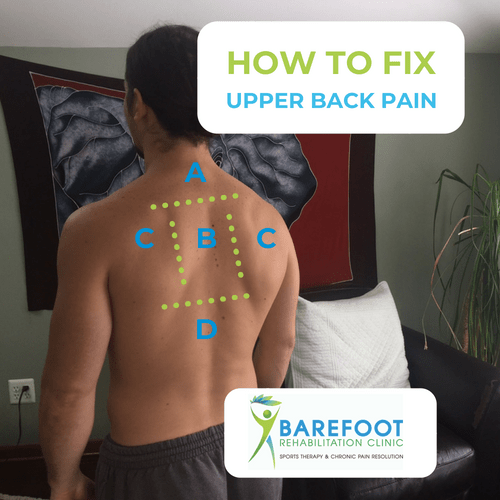
18 Jul How to Fix Upper Back Pain
When upper back pain stops responding to chiropractic adjustments, the foam roller, the lacrosse ball or gemini, it’s time to pause.
After all, Albert Einstein would not approve of the same behavior. It’s insanity.
Fixing your upper back pain requires that you put on your Albert Einstein Hat.
Just like a kid who puts on costumes and pretends he’s Superman, you need to use your noggin and think through what makes sense and what doesn’t for your body.
The risk is way too big otherwise.
Pain that lingers and doesn’t get fixed ultimately, gets worse as the years pass by.
So let’s be smart about this.
Ready to figure out what’s going on with your upper back pain?
Where is Your Upper Back Pain?
To fix your upper back pain, you need to know, with precision, two things:
- Exactly where your upper back pain is located.
- Exactly which body part is responsible for the pain you’re experiencing. (If you’re asking yoursef, “Aren’t they the same?” No, they aren’t.)
When a new patient comes into our office, they’ll say “I have upper back pain” when it’s actually a shoulder or neck problem or vice versa.
You and I need to agree on the location and probable area of problem before we try to fix it.
Otherwise, any intervention, therapy, or treatment is aimed at the wrong problem.
Open up a document or get a pen and paper to take notes. I’ll share an example of someone’s hypothetical notes below.
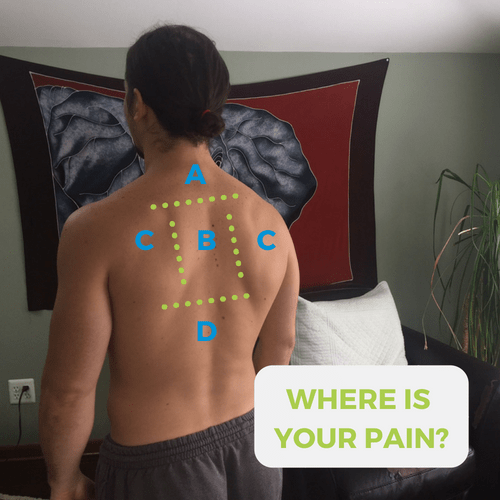
Is it above your shoulder blades, where “A” is? If YES, you have a NECK problem (write the location and problem area down).
Is it even on the horizontal plane with your shoulder blades, but off them, close to the spine, where “B” is? If YES, you have a NECK or UPPER BACK problem.
Is it on the shoulder blades, where “C” is? If YES, you have a probable SHOULDER problem or a small chance of a NECK problem.
Is it below the shoulder blades, where “D” is? If YES, you have a MID BACK problem.
Confirm the Problem Area for Your Upper Back Pain
If the human body and the pain signals it sends were simple, there’d be less people suffering.
Confirming the problem area for your upper back pain helps you increase the probability of pain relief in the future.
Kind of like shooting.
There are 5 bushes in front of you. If you know there’s a duck in a bush 1 (I must’ve been dreaming about Duck Hunt last night), shooting a shotgun into bush 1 will end up with high probability, hitting the duck.

But if you aren’t sure which bush the duck is in, shooting into bush 1 gives you a 20% chance of success.
Fortunately for our game, as long as you have 5 bullets, you can eventually hit the duck.
The stakes when it comes to your upper back pain that isn’t going away are way higher. We’re talking about your health, here. Go after the wrong bush, and now you’re 20 visits into a chiropractic or physical therapy treatment plan with 0% relief. Or you’ve gotten 2 cortisone shots with no effect. Or you’re now 70 years old, with progressively worsening upper back pain that is now much harder to fix.
Let’s find the bush that has your duck in it.
DO NOT SKIP THIS STEP OF FINDING THE RIGHT BUSH.
With my crystal ball, I already know that any of you who have had pain for less than 2 months have already stopped reading to try to find a simpler answer for your upper back pain on a less lengthy blog or on youtube. That’s fine.
Any of you who are still reading, it’s because your pain has lasted more than 2 months, even if it does come and go, or because your pain is nearly unbearable.
If this is you, YOU ARE READING THE RIGHT BLOG POST.
When you know with relative certainty:
My upper back pain is coming from my neck (or shoulder or upper back) …
… It allows you to immediately rule out stretching or strengthening for any other area that isn’t that problem area.
Or if a doctor says he wants to adjust your neck when you know you have an upper back problem, you can say:
Thanks, but no thanks (and go find another doctor).
Let’s confirm our bush.
How to Confirm a Neck Problem
You’ve already written down the location of your pain and the probable source of your pain from above.
It should read:
My Pain –> X
‘X’ is probably either: LOCATIONS OF PROBABLE PROBLEMS.
Now, write down:
Confirm LOCATION 1:
Confirm LOCATION 2:
Because it is extremely common, here is an example of someone with a probable neck disc problem. The location, “B”, combined with pain that worsens with sitting or neck motion is highly suggestive of a disc problem in the neck.
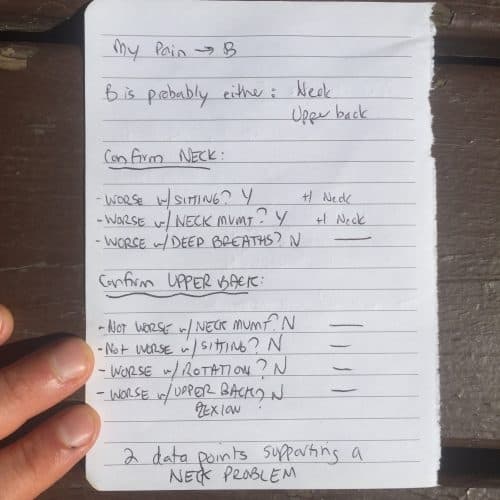
Now, you will determine the accuracy of the source of your pain.
For each of the data points below that is true, put a “+1 LOCATION” next to the data point.
Remember, the most common locations for a neck problem are “A” or “B”.
If your pain is …
- [WORSE WITH SITTING] … and you do not break the Sit-Slide-Lean Rule by using back support, you probably have a neck injury. Don’t get your big toe adjusted if you have a neck issue.
- [WORSE WITH NECK MOVEMENT] … like when you bring your chin to your chest or when your turn your head when you look out of the blind spot in your car, you probably have a neck injury.
- [WORSE WITH DEEP BREATHS] … or back (thoracic spine) rotation, you probably have an neck injury (and likely significant structural damage that would be confirmed with an MRI). If your pain is not located at “A” or “B”, you probably have a intercostal or rib injury.
How to Confirm a Shoulder Problem
Remember, the most common area for shoulder problems in our diagram is “C”. There are other locations where should pain will express itself, but for the purpose of this post, we won’t discuss them here.
If your pain is …
- [WORSE WITH SHOULDER MOVEMENT?] … worse with bringing your biceps to your ears (see video below), you probably have a shoulder injury.
- [WORSE WITH SHOULDER EXERCISES?] … worse with shoulder exercises that don’t also stress the neck, you probably have a shoulder injury. i.e. If you have pain with push-ups but not with strict presses overhead, then this is confirmed.
How to Confirm an Upper Back Problem
Remember, the most common location for an upper back problems is “B”.
If your pain is …
- [NOT WORSE WITH NECK MOVEMENT] … you probably have an upper back injury. Your doctor will need a good reason to keep treating your neck if this is the case.
- [NOT WORSE WITH SITTING] … and you do not break the Sit-Slide-Lean Rule by using back support, you probably have an upper back injury.
- [WORSE WITH ROTATION?] … worse with upper back rotation while the neck stays neutral (see video below), you probably have a intercostal or rib injury. Therefore, you should get the ribs and rib muscles worked on.
- [WORSE WITH UPPER BACK FLEXION?] … worse with upper back flexion while the neck stays neutral, you probably have a upper back injury.
A Quick Note on Constant Pain That is Never Relieved
Pain that is constant means that whatever body part is damaged is either:
- inflamed (trying to heal) and/or
- constantly being over-stressed (you’re doing too much)
With almost 100% certainty, you have some level of structural damage (more than a muscle problem) or wear-and-tear that warrants imaging.
X-rays visualize bone and are relatively pointless when it comes to pain that has lasted more than two months. We almost never order x-rays in our pain clinic.
MRIs visualize cartilage, labrums, and discs. We almost always order MRIs or arthrograms for the shoulder and hip if we suspect a labrum problem.
Your medical doctor may want to prescribe anti-inflammatories or steroids to help you. I do NOT recommend you take anti-inflammatories, steroids, or cortisone. There is a reason your body is inflamed and it’s not because of a steroid-deficiency. While these treatments will make you feel better, they are doing nothing to address the actual problem causing your pain.
How to Get Fix Your Upper Back Pain
Now that you know the probable problem area that is causing your upper back pain, you can pursue self-treatment or treatment for this problem.
Having done this work puts you way ahead of anyone who is blindly foam-rolling or massaging the pain just because that’s where you feel it. The body deserves more respect than that.
If you’re going to self-treat through foam-rolling, lacrosse-balling or you’re going to get adjusted, try acupuncture, or get a massage, you have 2 months to significantly relieve your problem.
Here’s a video of some decent strengthening and stretching exercises:
Or if your biased towards yoga, here you go:
If your pain isn’t better in 2 months of consistent work at least 3-5 days/week (or if you’ve already had your pain for more than 2 months), then you’ll need to find an adhesion specialist to fix your pain.
Adhesion is the most common cause of all musculoskeletal pain that almost no one talks about and is very easily removed by an expert. It acts like glue that causes your muscles to become tight and weak.
I live in New Jersey and fly/drive to Boston or Chicago at least once/month and pay $400 for my own treatments because I want the best care for my body. Unfortunately, if you want to get out of pain, it means doing what you have to do to achieve your desired result (pain relief, duh).
Below are two images of what effective treatment looks like for upper back pain coming from a neck AND upper back problem.
This patient was 80% better with his upper back and shoulder pain after treating and removing all adhesion from his neck.
15% more relief was achieved by treating his upper back.
The last 5% of pain was not fixable due to structural damage in his neck and shoulder.
Notice, his upper back is flat before treatment (pre-treatment) for 4″. His upper back is not flexing (or not rounding) as well as it should.
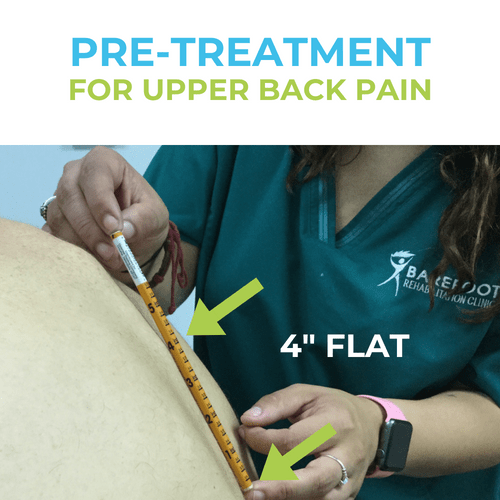
Now, notice his upper back is flat against the pencil after treatment (post-treatment) for 2.5″. He has more flexion (and rounding) in his upper back.
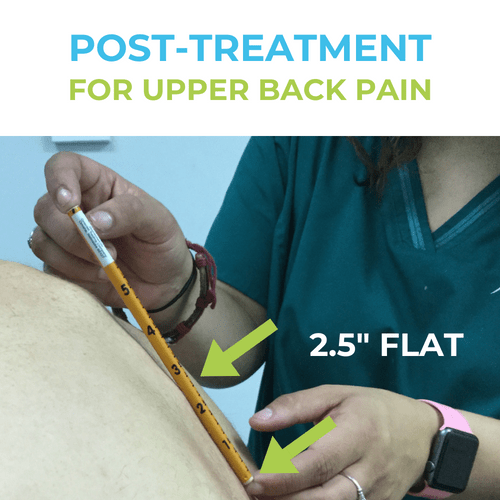
Congratulations for making it all the way through this read.
With your Albert Einstein hat on, you have, unfortunately, done more diagnostic work than most doctors do.
Fortunately for you, you advocate for your own health and can get yourself out of pain by using your brain. : )
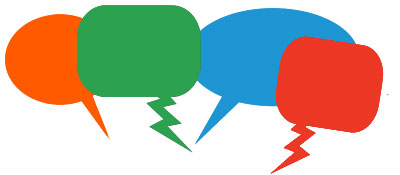 Do you have upper back pain? Share your self-diagnosing below. If you want to share more information, include your age, sex, the quality of your pain (achey, burning, numb, tingling, etc.), how severe it is on a scale from 0-10, and any other information as far as what makes it worse or better. Let me know how long you’ve had it and what you think caused the pain to occur. If you don’t share ALL of these details, it will be really hard for me to give you direction.
Do you have upper back pain? Share your self-diagnosing below. If you want to share more information, include your age, sex, the quality of your pain (achey, burning, numb, tingling, etc.), how severe it is on a scale from 0-10, and any other information as far as what makes it worse or better. Let me know how long you’ve had it and what you think caused the pain to occur. If you don’t share ALL of these details, it will be really hard for me to give you direction.
PS. I was a part of an expert round-up on fixing back pain. Look through the 53 tips and see where you can change something, right now, to relieve your upper back pain.


Zoe Alcorn
Posted at 03:16h, 24 OctoberI have really bad pain in area c all the time. I have a neck problem and that causes it. I’ve learned to live with it and I’ve had it for a few years. My upper neck leans in and the vertibray is twisted. I can live with it but it hertz really bad sometimes. I’m 14 and a female.
Dr. Chris
Posted at 12:45h, 26 OctoberHi Zoe, I’m sorry for your pain. Does your pain INCREASE with the SHOULDER test or with NECK movement?
Based on what you said, it sounds like it’s going to be neck. But confirm it with neck turning and bringing your chin to your chest and bring your head backwards like you’re looking at the ceiling.
As a 14 year old, it’s going to be really important that you start a strengthening fitness program. Most of the teenagers we treat have horrible posture, sit with bad posture, and have pain due to the muscles being weak.
You’re not going to crazy with workouts – but you’re going to do a “MIDDLE” amount of work that strengthens your back and shoulders.
Sharon Ellison-Sobutka
Posted at 13:38h, 06 NovemberMy back pain is in the D area and sometimes wraps around my miss section like a belt that sometimes makes it difficult to take deep breaths (after sleeping). There seems to be a localized origin on the left side of the D area.
6 years ago I tore, and be I’m guessing, my rotator cuff. It has never healed and now affects my neck on the left side.
I’m not sure if they are related because answering all your questions indicates a probably back problem.
I do have osteoarthritis, Im only 47 and need both knees replaced because of it.
I’m leaning towards a disc compression of some type that’s not related to my shoulder injury (I could be wrong) but it’s getting worse because I can feel it all the time now.
It’s aggravating.
Sharon Ellison-Sobutka
Posted at 13:53h, 06 NovemberMy back pain doesn’t increase with shoulder or neck movement, it does if I turn my torso though in either direction.
Dr. Chris
Posted at 00:52h, 28 JanuaryMost likely a thoracic problem then.
andrew greenstein
Posted at 02:33h, 23 MayThe worst of my pain is right on and just below the position of the letter B
I have varying degrees of stenosis from mild (C3-4, left)…to moderate (C4-6, left)…to severe (C6-7 bilateral).. C5-6 has a significant herniation.
I had a decompression surgery this year to the left side of C5-6 and C6-7– only on the left. It didn’t really fix the strong upper back pain– but I do think it’s much more apparent on the right side–which wasn’t worked on now–not the left side as much– Hard to tell as it “feels” so close to my spine.
Sometimes, it branches out right and left- — I feel like it begins around my right shoulder blade–then everything else spasm–and then I get a “knife” feeling in my spine and slightly to the right of it….
My thoracic spine doesn’t show much– Maybe very mild stenosis here and there–and some facet hypertrophy….
I’ve tried chiro, physical therapy, myofacscial massage, and am currently completing 30 sessions of A.R.T.
andrew greenstein
Posted at 02:36h, 23 MayI would like to add.. BY FAR, my pain is the worst when I’m STANDING.. It is sometimes impossible to stand for more than a few minutes..especially to stand still (i.e. waiting in line, talking face to face w/ anyone)
Dr. Chris
Posted at 19:16h, 23 MayGot it. What adhesion is the ART treating? If you don’t get some % of permanent relief in 5 visits, stop going. MAR (Manual Adhesion Release) docs typically use this 5 visit rule so as not to waste our patients time or money.
andrew greenstein
Posted at 03:57h, 24 MayMy understanding from my ART therapist is I “have a lot going on” and “a lot of adhesions”– Various points around my left and right shoulder blades, just below them, and my neck….I had some* positive response…then went backwards… now it’s slowly coming up again– It’s been 14 years of pain though–and “only” about 15 sessions so far
Dr. Chris
Posted at 19:03h, 30 MayYeah, sounds complex. But 15 visits for 0% relief would never happen in our office. We would’ve stopped seeing you. Just our 2c.
Wendell
Posted at 23:52h, 15 OctoberWas lying on my left side in bed. When I went to get up pain in the A an C area was not able to turn head fully left without pain in A or C area or touch my left shoulder blade with left hand on left shoulder blade without pain in lower C area. I assume it was from laying to relaxed in one position. But it won’t subside.
Dr. Chris
Posted at 19:03h, 17 OctoberSounds like a cervical disc issue. This is what you need to get diagnosed and treated. It probably wouldn’t hurt to get an MRI.
Abby Leanne
Posted at 08:33h, 06 AprilI’ve had upper back pain in area B for around 5 years now, to be precise it’s just under and to the right of the B. Ive been going to an osteopath for around 6 months and he knows where the pain is but doesn’t seem to relive it, I was always worried about it being an issue with my lung but after 5 years I would have thought it would have got worse by now, I’m a taxi driver and I drive mainly using just my right arm and do lean. And my posture isn’t great and my neck and back always seem to click a lot or feel the need to click. Wondering is this a neck or back problem? Thank you for taking the time to read.
Dr. Chris
Posted at 12:27h, 07 AprilHI Abby, “B” is either a neck and/or an upper back problem. Chronic pain located here is much harder to fix than other body areas. So you REALLY need a specialist to get this fixed. Someone who has a track record of fixing these things.
Shannon Barry
Posted at 10:17h, 10 OctoberI am 25, female, and have achy mid back pain, and burning upper back pain around the A area. It has been at least 3 years since the pain started. It varies on a scale of 1-10 from 5-9. The longer I stand the more it hurts. The muscle tension in my back also causes my migraines (according to a neurologist I saw 3 years ago- she prescribed massages to relive the migraines which worked). I’ve been to a chiropractor before which didn’t seem to make a difference. I also have a sports massage/ deep tissue with a physical therapist every few weeks. However the pain consistently comes back. At the moment I’m having massages more regularly because the pain is coming back sooner. Heat helps the pain, sitting relives the pain but not the aching. Lying on my stomach seems to relive the pain too.
I don’t know if the cause is stress, or need to exercise more? Not sure what to do really.
Dr. Chris
Posted at 15:11h, 29 OctoberHi Shannon,
It sounds like adhesion is your problem. I’d see an adhesion specialist. After the adhesions are removed, you need to strengthen. Where do you live?